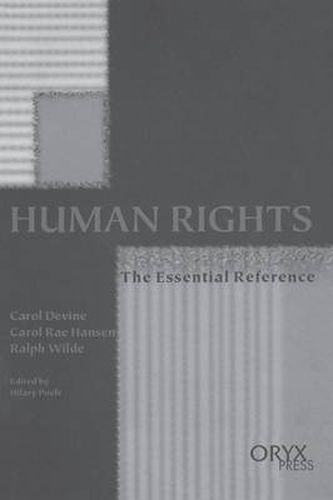Readings Newsletter
Become a Readings Member to make your shopping experience even easier.
Sign in or sign up for free!
You’re not far away from qualifying for FREE standard shipping within Australia
You’ve qualified for FREE standard shipping within Australia
The cart is loading…






The United Nations has declared the years 1995-2005 the Decade of Human Rights, and the study of these basic rights is becoming an increasingly important part of the social studies, history and civics curricula. This text covers a broad range of human rights issues that are central to an understanding of world history and current affairs. It is divided into four main sections. Part 1 traces the evolution of the concept of human rights from the classical world to the 1948 adoption of the Universal Declaration of Human Rights. Part 2 provides a detailed explanation of all 30 articles of the Universal Declaration, the document that defines the understanding of human rights. Part 3 offers an overview of the post-1948 human rights movement and its key players, including: descriptions of UN, governmental and non-governmental organizations throughout the world along with their addresses, phone numbers, and e-mail and Web addresses; and biographical sketches of individuals who have had significant impact on the human rights movement, such as Peter Benenson, the founder of Amnesty International, Aung San Suu Kyi, democracy activist in Myanmar, and Jody Williams, American coordinator of the International Campaign to Ban Landmines. Part 4 outlines the major issues in human rights movement, including such key topics as: asylum for refugees; child soldiers; the death penalty; female genital mutilation; genocide; child labour; conscientious objection; extra-judicial detentions; gender-related persecution; and land mines.
$9.00 standard shipping within Australia
FREE standard shipping within Australia for orders over $100.00
Express & International shipping calculated at checkout
The United Nations has declared the years 1995-2005 the Decade of Human Rights, and the study of these basic rights is becoming an increasingly important part of the social studies, history and civics curricula. This text covers a broad range of human rights issues that are central to an understanding of world history and current affairs. It is divided into four main sections. Part 1 traces the evolution of the concept of human rights from the classical world to the 1948 adoption of the Universal Declaration of Human Rights. Part 2 provides a detailed explanation of all 30 articles of the Universal Declaration, the document that defines the understanding of human rights. Part 3 offers an overview of the post-1948 human rights movement and its key players, including: descriptions of UN, governmental and non-governmental organizations throughout the world along with their addresses, phone numbers, and e-mail and Web addresses; and biographical sketches of individuals who have had significant impact on the human rights movement, such as Peter Benenson, the founder of Amnesty International, Aung San Suu Kyi, democracy activist in Myanmar, and Jody Williams, American coordinator of the International Campaign to Ban Landmines. Part 4 outlines the major issues in human rights movement, including such key topics as: asylum for refugees; child soldiers; the death penalty; female genital mutilation; genocide; child labour; conscientious objection; extra-judicial detentions; gender-related persecution; and land mines.